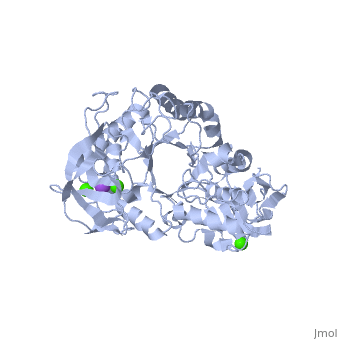Raghad zoubi
From Proteopedia
(Difference between revisions)
| Line 3: | Line 3: | ||
== Introduction == | == Introduction == | ||
| - | The <scene name='60/609816/Alpha-amylase/1'>Alpha-amylase</scene> (EC 3.2.1.1 ) (CAS# 9014-71-5) (alternative names: 1,4-α-D-glucan glucanohydrolase; glycogenase) are calcium metalloenzymes, completely unable to function in the absence of calcium. By acting at random locations along the starch chain, α-amylase breaks down long-chain carbohydrates, ultimately yielding maltotriose and maltose from amylose, or maltose, glucose and "limit dextrin" from amylopectin. Because it can act anywhere on the substrate, α-amylase tends to be faster-acting than β-amylase. In animals, it is a major digestive enzyme, and its optimum pH is 6.7–7.0 | + | The <scene name='60/609816/Alpha-amylase/1'>Alpha-amylase</scene> (EC 3.2.1.1 ) (CAS# 9014-71-5) (alternative names: 1,4-α-D-glucan glucanohydrolase; glycogenase) are calcium metalloenzymes, completely unable to function in the absence of calcium. By acting at random locations along the starch chain, α-amylase breaks down long-chain carbohydrates, ultimately yielding maltotriose and maltose from amylose, or maltose, glucose and "limit dextrin" from amylopectin. Because it can act anywhere on the substrate, α-amylase tends to be faster-acting than β-amylase. In animals, it is a major digestive enzyme, and its optimum pH is 6.7–7.0 |
In human physiology, both the salivary and pancreatic amylases are α-amylases. | In human physiology, both the salivary and pancreatic amylases are α-amylases. | ||
| Line 18: | Line 18: | ||
</StructureSection> | </StructureSection> | ||
== References == | == References == | ||
| - | + | {{http://en.wikipedia.org/wiki/Amylase}} | |
<references/> | <references/> | ||
Revision as of 16:03, 22 November 2014
Example page for α-Ameylase
| |||||||||||
References
Template:Http://en.wikipedia.org/wiki/Amylase

